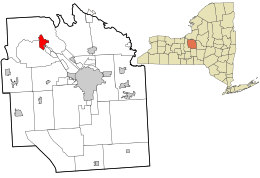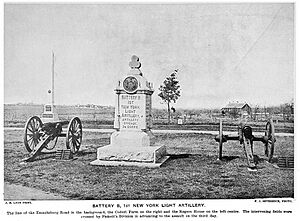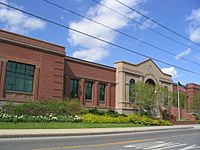Baldwinsville, New York facts for kids
Quick facts for kids
Baldwinsville, New York
|
|
|---|---|
|
Village
|
|

The Emita II passes through Lock 24 across from Paper Mill Island in downtown Baldwinsville.
|
|
| Nickname(s):
B'ville
|
|
| Motto(s):
Lock Into an Experience
|
|

Location in Onondaga County and the state of New York.
|
|
| Country | United States |
| State | New York |
| County | Onondaga |
| Area | |
| • Total | 3.36 sq mi (8.71 km2) |
| • Land | 3.19 sq mi (8.26 km2) |
| • Water | 0.17 sq mi (0.45 km2) |
| Elevation | 381 ft (116 m) |
| Population
(2020)
|
|
| • Total | 7,898 |
| • Density | 2,475.86/sq mi (956.04/km2) |
| Time zone | UTC-5 (Eastern (EST)) |
| • Summer (DST) | UTC-4 (EDT) |
| ZIP code |
13027
|
| Area code(s) | 315 |
| FIPS code | 36-04198 |
| GNIS feature ID | 0942909 |
Baldwinsville is a charming village in Onondaga County, New York, United States. In 2020, about 7,898 people lived there. It's part of the larger Syracuse area. Many locals call it "B’ville" for short.
The village of Baldwinsville is located where the towns of Lysander and Van Buren meet. It sits right on the Seneca River. Some areas with a Baldwinsville mailing address are also in the town of Clay.
Contents
Discovering Baldwinsville's Past
Baldwinsville is named after Dr. Jonas Baldwin. He was important because he built a dam across the Seneca River. This dam helped create energy for mills. He also built a private canal to help boats travel easily. The community was officially named the Village of Baldwinsville in 1848. Before that, it had other names, like McHarrie's Rifts.
How Baldwinsville Grew
Baldwinsville first became a busy center for farming. Many mills were built along the Seneca River. A canal on the north side of the river helped boats go around the dam. Later, in the early 1900s, the New York State Barge Canal was built on the south side. This new canal made river travel even better. Around the same time, a railway connected Baldwinsville to Syracuse and Oswego.
Besides farming, Baldwinsville had small factories. These included Morris Machine Works and Jardine Bronze Foundry. In the 1970s, a large brewery was built nearby. It used the fresh water from Lake Ontario. Today, Baldwinsville is a lovely riverside community.
Important Historical Places
Grace Episcopal Church was one of the first churches in the United States to use electric lights.
Many young men from Baldwinsville fought in the American Civil War. Their names are on a monument in the village cemetery. They served in different parts of the Union Army. Some fought with General John A. Logan in William T. Sherman's army. Others were in the 1st Regiment, Light Artillery, Battery B. This group fought in major battles like:
- Antietam, Maryland (1862)
- Battle of Fredericksburg (1862)
- Battle of Chancellorsville (1863)
- Battle of Gettysburg (1863)
- Battle of Spotsylvania (1864)
- Petersburg, Virginia (1864)
Several buildings in Baldwinsville are listed on the National Register of Historic Places. These include the Baldwinsville Village Hall, the Mrs. I. L. Crego House, and the Oswego-Oneida Streets Historic District.
Learning in Baldwinsville
The Baldwinsville Central School District serves the village. It has one high school, C.W. Baker High School. There is also Donald S. Ray Middle School and Theodore R. Durgee Junior High School. The district has five elementary schools: Harry E. Elden, Catherine McNamara, L. Pearl Palmer, Mae E. Reynolds, and Martin Van Buren.
There are also private Christian schools in the area. These include Baldwinsville Christian Academy and Word of Life Christian Academy.
Baldwinsville's Community Life
Baldwinsville hosts several fun community events each year.
Festivals and Events
The Baldwinsville Oktoberfest is a popular festival held every September. It celebrates the village and helps raise money for local charities.
The Rotary Club organizes the Seneca River Days festival in June. This event used to be called John McHarrie Day. A highlight of the festival is the "anything that floats race." Teams build floating vehicles with a small budget and race them! Many events take place at the amphitheater on Paper Mill Island.
Local and national bands often play on weekends during the summer. A special memorial for the September 11 attacks was built and shared with the community on the 10-year anniversary.
Geography and Nature
Baldwinsville is located at 43°10′N 76°20′W. The Seneca River flows right through the village. It goes through the historic downtown area and is part of the Erie Canal. Lock 24 on the canal has a popular local restaurant.
The village covers about 3.2 square miles (8.26 square kilometers) of land. A small part, about 0.2 square miles (0.45 square kilometers), is water.
Landscape and Climate
Baldwinsville is built on gentle hills. It's close to Lake Ontario and the Finger Lakes. The land changes from flat plains near Lake Ontario to rolling hills further south. These hills lead towards the Allegheny Mountains. The area has forests, meadows, farms, and many types of water bodies. The seasons bring big changes in weather.
The soil is rich and varied, left behind by glaciers long ago. This makes the land great for farming fruits and vegetables. The "lake effect" from Lake Ontario makes winters less harsh than areas north of the lake. However, this means the region gets a lot of snow. High rainfall and snowfall mean there's plenty of water.
Local Ecosystem
Baldwinsville is in a region full of rivers, lakes, streams, and marshes. The forests are mostly Sugar Maple trees, but many other tree types grow here too. There's lots of wildlife, and many kinds of fish live in the Seneca River.
The Seneca River connects to Lake Ontario through the Oswego River. Because of international shipping, tiny creatures called zebra mussels have entered the Great Lakes and the river. These mussels have made the river water much clearer. This has caused more water plants to grow along the banks.
Weather in Baldwinsville
Baldwinsville has a humid continental climate. This means it has big differences in temperature between seasons. Summers are warm to hot, and winters are cold, sometimes very cold. Winters can feel like they last for more than half the year!
People of Baldwinsville
As of 2020, the population of Baldwinsville was 7,898 people. The village is home to many different families and individuals.
Famous People from Baldwinsville
Many interesting people have come from Baldwinsville!
- Marty Ashby – A talented jazz guitarist and music producer.
- William Martin Beauchamp – A clergyman who studied the history of the Haudenosaunee (Iroquois) people.
- Alex Bono – A professional soccer player who plays as a goalkeeper.
- Tim Connolly – A professional ice hockey player.
- Benjamin Gerardi – The founder of Farm Swarming INC and a Fulbright Award-winner.
- Jason Grilli – A professional baseball pitcher.
- Christine Hallquist – A candidate for Governor of Vermont.
- Post Malone – A famous rapper, singer, songwriter, and actor.
- Cristoval Nieves – A professional hockey player.
- Don Paige – An Olympic team member for the 800m race and a former world record holder.
- Robert Starling Pritchard – A concert pianist and humanitarian.
- George Sullivan – A football player from the 1920s.
- Justin Torres – An American novelist and winner of the 2023 National Book Award for Fiction.
- Alex Tuch – A professional hockey player.
See also
 In Spanish: Baldwinsville para niños
In Spanish: Baldwinsville para niños



